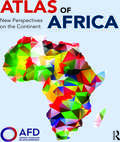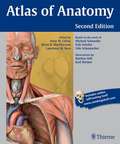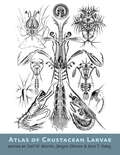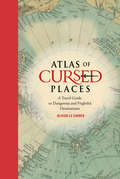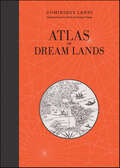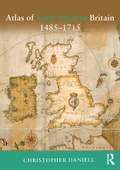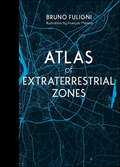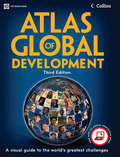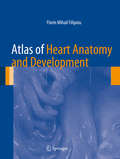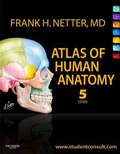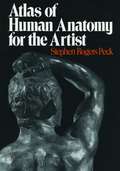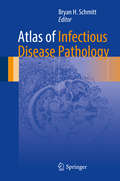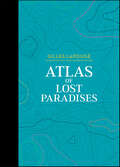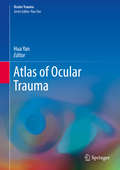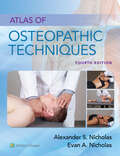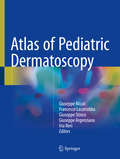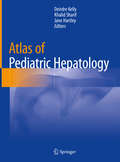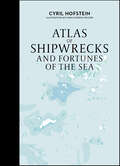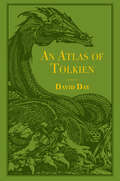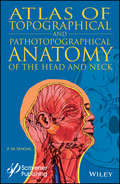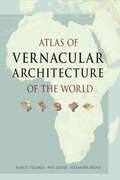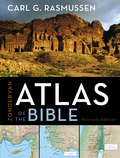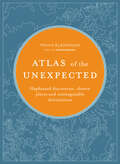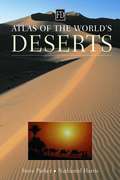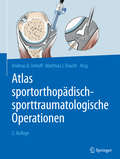- Table View
- List View
Atlas of Africa: New Perspectives on the Continent
by Dunod Editeur Agence Française de DéveloppementThis innovative Atlas of Africa, by the Agence Française de Développement, offers comprehensive insights into contemporary Africa through the use of full-colour maps, charts, graphics and text which demonstrate and explain Africa’s growing importance in the world and its demographic, economic, social and environmental transformation, while also outlining the challenges that the continent faces. The three sections, offering new perspectives on the continent, comprise: Taking Full Measure of Africa – examining the major economic, demographic, social and political transformations that Africa has undergone in a short space of time. A Multifaceted Continent with Shared Challenges – looking at the major intraregional economic, demographic, environmental and social dynamics that are currently shaping the continent. Africa Inventing Itself and Taking up the Key Challenges of Tomorrow – an overview of the challenges that Africa is currently facing and will need to face in the future, including the environment and climate change, social cohesion and demographic issues, economic development and governance. Full-colour maps, charts and graphics cover such wide-ranging topics as economic development, urbanization, education, the rule of law, gender, the blue economy, regional organizations, energy and culture, to form a volume which offers a wide-ranging overview in graphic form of Africa in the world today, of interest to all those studying, working in or with Africa, and those with a general interest in the continent.
Atlas of Anatomy (2nd Edition)
by Anne M. Gilroy Brian R. Macpherson Lawrence M. Ross Michael Schünke Erik Schulte Udo SchumacherThis color illustrated reference for students of gross anatomy offers material in self-contained two-page spreads, illustrated with a total of 2,400 color anatomical illustrations and diagnostic images with call-out labels and captions noting clinical correlations. Material is presented in units on body regions: back, thorax, abdomen, pelvis and perineum, upper limb, lower limb, head and neck, and neuroanatomy. Each unit starts with surface anatomy, then represents bones, muscles, vasculature, and nerves, and closes with a topographical summary of the area. This second edition contains new sectional anatomy spreads at the end of each major unit; surface anatomy spreads now include region and reference lines. Some content has been reorganized to more closely parallel the progression and content of a typical dissection curriculum. Much of the artwork is new for this edition. The companion website contains labeled and unlabeled images from the book, plus timed self-tests. Annotation ©2012 Book News, Inc. , Portland, OR (booknews. com)
Atlas of Crustacean Larvae
by Joel W. Martin, Jørgen Olesen, and Jens T. Høeg.An illustrated guide to the sweeping diversity of crustacean larval forms.Winner of the CHOICE Outstanding Academic Title of the Choice ACRLCrustaceans—familiar to the average person as shrimp, lobsters, crabs, krill, barnacles, and their many relatives—are easily one of the most important and diverse groups of marine life. Poorly understood, they are among the most numerous invertebrates on earth. Most crustaceans start life as eggs and move through a variety of morphological phases prior to maturity. In Atlas of Crustacean Larvae, more than 45 of the world's leading crustacean researchers explain and illustrate the beauty and complexity of the many larval life stages.Revealing shapes that are reminiscent of aliens from other worlds—often with bizarre modifications for a planktonic life or for parasitization, including (in some cases) bulging eyes, enormous spines, and aids for flotation and swimming—the abundant illustrations and photographs show the detail of each morphological stage and allow for quick comparisons. The diversity is immediately apparent in the illustrations: spikes that deter predators occur on some larvae, while others bear unique specializations not seen elsewhere, and still others appear as miniature versions of the adults. Small differences in anatomy are shown to be suited to the behaviors and survival mechanisms of each species.Destined to become a key reference for specialists and students and a treasured book for anyone who wishes to understand "the invertebrate backbone of marine ecosystems," Atlas of Crustacean Larvae belongs on the shelf of every serious marine biologist.
Atlas of Cursed Places: A Travel Guide to Dangerous and Frightful Destinations
by Olivier Le CarrerOliver Le Carrer brings us a fascinating history and armchair journey to the world's most dangerous and frightful places, complete with vintage maps and period illustrations in a handsome volume. This alluring read includes 40 locations that are rife with disaster, chaos, paranormal activity, and death. The locations gathered here include the dangerous Strait of Messina, home of the mythical sea monsters Scylla and Charybdis; the coal town of Jharia, where the ground burns constantly with fire; Kasanka National Park in Zambia, where 8 million migrating bats darken the skies; the Nevada Triangle in the Sierra Nevada mountains, where hundreds of aircraft have disappeared; and Aokigahara Forest near Mount Fuji in Japan, the world's second most popular suicide location following the Golden Gate Bridge.
Atlas of Dream Lands (Atlas Series)
by Dominique LanniA keepsake collection of maps depicting legendary and real places for the lover of literature, history, and cartography. This exploration of the "Mythical Elsewhere" explores a wide array of places, from the well known to the obscure, through the eyes of historians, explorers, conquerors, and writers across the ages. Lose yourself in the past as you travel to such destinations as Troy, the Mughal Empire, the Congo, the river Nile, El Dorado, and many more across the globe:Europe: Candia, Kythira, Ogygia, TroyAsia: Cathay, Cipangu, Colchis, the Mughal Empire, Golconda, Kafiristan, the Land of the Cimmerians, Taprobana, TartaryAfrica: Barbary Coas, Cape Bojador, Congo, Meroë, Mutapa, the Land of the Mangbetu, Prester John&’s Kingdom, the Kingdom of Saba&’, the Source of the River Nile, the Lands of Good HopeThe Americas: Araucanía, Cibola, El Dorado, the Land of the Amazons, Tierra del FuegoSouthern Lands: New Cythera, Terra Australis the Edge of the World: the Isles of the Blessed, the Garden of the Hesperides, Lemuria, Thule Accompanied by this unique atlas and the great explorers of antiquity and Renaissance as well as poets, scholars, and novelists of all eras, readers will embark on a poetic exploration of the world. Let such greats as Herodotus, Marco Polo, Christopher Columbus, and Heinrich Schliemann be your guide on this journey to dreamlike places that are sometimes imagined and imaginary but, to those who believe, always &“perfectly real.&”? It's a trip you will never forget.
Atlas of Early Modern Britain, 1485-1715
by Christopher DaniellThe Atlas of Early Modern Britain presents a unique visual survey of British history from the end of the Wars of the Roses through to the accession of George I in 1715. Featuring 117 maps, accompanied throughout by straightforward commentary and analysis, the atlas begins with a geographical section embracing England, Scotland, Ireland and Wales and providing clear orientation for the reader. It then focuses separately on the sixteenth and seventeenth centuries, dividing its coverage of each into four key themes: Geography and Counties - Outlining in detail how Britain's geography was shaped during the period; Politics and War - the main campaigns, rebellions and political changes in each century; Religion - including denominational concentrations, diocesan boundaries and witch trials; Economy and Culture -charting Britain's wealthiest towns, the locations of Britain's houses of aristocracy and the effects of The Great Fire of London; The broad scope of the atlas combines essential longer-term political, social, cultural and economic developments as well as key events such as the Spanish Armada, the Dissolution of the Monasteries, the Civil War and the Glorious Revolution. Its blend of clear visual aids and concise analysis represents an indispensable background and reference resource for all students of the early modern period.
Atlas of Extraterrestrial Zones (Atlas Ser. #2)
by Bruno Fuligni32 unusual and fascinating extraterrestrial encounters that explores the places and portals between our world and theirs, with illustrated maps for each location (Book 2 of the bestselling Atlas series) Where is the best place to meet kind and peaceful aliens? How do we communicate with intelligent interstellar life forms, socialize with Martians, and avoid unwanted close encounters of the third kind? These and other answers to ET mysteries are captured in the thirty-two stories in the Atlas of Extraterrestrial Zones, where maps direct readers to the portals that open up between the worlds, a geography of strange events that covers the entire earth, demonstrating how widespread the phenomenon is. Learn about locations of extraterrestrial sightings, hidden bases, secret embassies, and long-lost traces of thousand-year-old passages. From the UFO port of Arès to the underground center of Area 51, from the crash at Roswell to setting up the SETI program, this atlas lists, for the first time, the meeting points between earthlings and these mysterious extraterrestrial biological entities (EBEs).
Atlas of Global Development
by The World BankPublished in association with Harper Collins, the completely revised and updated third edition of the Atlas of Global Development vividly illustrates the key development challenges facing our world today. 'This is an excellent, up-to-date source book which will be invaluable for students of, and staff teaching, higher levels of geography .... a clear, concise, easily-accessible and well-illustrated volume.' - Geographical Association, United Kingdom
Atlas of Heart Anatomy and Development
by Florin Mihail FilipoiuThis heart anatomy book describes the cardiac development and cardiac anatomy in the development of the adult heart, and is illustrated by numerous images and examples. It contains 550 images of dissected embryo and adult hearts, obtained through the dissection and photography of 235 hearts. It has been designed to allow the rapid understanding of the key concepts and that everything should be clearly and graphically explained in one book. This is an atlas of cardiac development and anatomy of the human heart which distinguishes itself with the use of 550 images of embryonic, fetal and adult hearts and using text that is logical and concise. All the mentioned anatomical structures are shown with the use of suggestive dissection images to emphasize the details and the overall location. All the images have detailed comments, while clinical implications are suggested. The dissections of different hearts exemplify the variability of the cardiac structures. The electron and optical microscopy images are sharp and provide great fidelity. The arterial molds obtained using methyl methacrylate are illustrative and the pictures use suggestive angles. The dissections were made on human normal and pathological hearts of different ages, increasing the clinical utility of the material contained within.
Atlas of Human Anatomy
by Frank H. NetterAtlas of Human Anatomy uses Frank H. Netter, MD's detailed illustrations to demystify this often intimidating subject, providing a coherent, lasting visual vocabulary for understanding anatomy and how it applies to medicine. This 5th Edition features a stronger clinical focus-with new diagnostic imaging examples-making it easier to correlate anatomy with practice. Student Consult online access includes supplementary learning resources, from additional illustrations to an anatomy dissection guide and more. Netter. It's how you know. See anatomy from a clinical perspective with hundreds of exquisite, hand-painted illustrations created by, and in the tradition of, pre-eminent medical illustrator Frank H. Netter, MD. Join the global community of healthcare professionals who've mastered anatomy the Netter way Expand your study at studentconsult. com, where you'll find a suite of learning aids including selected Netter illustrations, additional clinically-focused illustrations and radiologic images, videos from Netter's 3D Interactive Anatomy, dissection modules, an anatomy dissection guide, multiple-choice review questions, drag-and-drop exercises, clinical pearls, clinical cases, survival guides, surgical procedures, and more. Correlate anatomy with practice through an increased clinical focus, many new diagnostic imaging examples, and bonus clinical illustrations and guides online.
Atlas of Human Anatomy for the Artist
by Stephen Rogers PeckStephen Rogers Peck's Atlas of Human Anatomy for the Artist remains unsurpassed as a manual for students. It includes sections on bones, muscles, surface anatomy, proportion, equilibrium, and locomotion. Other unique features are sections on the types of human physique, anatomy from birth to old age, an orientation on racial anatomy, and an analysis of facial expressions. The wealth of information offered by the Atlas ensures its place as a classic for the study of the human form.
Atlas of Infectious Disease Pathology (Atlas of Anatomic Pathology)
by Bryan H. SchmittProvides a comprehensive overview of the histopathology of the majority of infectious diseases.<P><P> Richly illustrated Atlas with 418 full color photographs.<P> Written by experts in the field.<P> Infectious diseases may be encountered in nearly every aspect of pathology. This atlas provides an informative reference for the identification of the common and esoteric pathogens, presenting in a wide array of specimen types. The focus of the presented images is on the hematoxylin and eosin-stained appearances of these infections and highlight common special stains that can be used to aid in the diagnosis of the infectious agent. Where appropriate, commentary regarding additional testing such as immunohistochemistry and molecular-based methods is supplied. The Atlas of Infectious Disease Pathology is organized primarily by pathogen type followed by discussion of the various manifestations that may occur in individual organ systems. The reader will be provided with a comprehensive overview of the histopathology of the majority of infectious diseases encountered in general and subspecialty practice alike.
Atlas of Lost Paradises (Atlas Series #3)
by Gilles LapougeThoroughly documented, a worldwide selection of places representing many attempts made by mankind through the ages to re-create a paradise on Earth. "Paradises got off to a bad start early on. The one the Bible had arranged had to rapidly close its pearly gates when its first two occupants, Adam and Eve, had misbehaved." According to Gilles Lapouge, paradise is a paradoxical creation of our imagination, blending hope and nostalgia. Historically, mankind has sought to fashion a paradise, which could be accessed during its lifetime: ideal cities, cities made of glass and steel, castles of freedom, etc. This atlas embarks us upon a journey across civilizations, through the exploration of 27 real or fictional places, including • gardens of the Middle Ages • Atlantis • the castles of King Ludwig II • Oceana • Pitcairn Island • city of Manoa • Mausoleum of Qin Shi Huang Each place is illustrated with a specially designed map in a graphic style that has become the hallmark of this Atlas series.
Atlas of Ocular Trauma (Ocular Trauma)
by Hua YanThis book aims to provide comprehensive pictures of ocular trauma illustrating signs, examinations and surgical procedures to clinical practitioners including the nurses, medical students, residents, fellows and ophthalmologists, and help them make the appropriate decision on the diagnosis and management of such patients. <p><p> The first chapter gives a general introduction of ocular trauma which helps clinical practitioners generate the basic ideas of classification of ocular trauma and understand general principles of examination and first-aid management of such patients. The following chapters cover all types of ocular trauma with the comprehensive pictures combined with brief case studies. For each disease, a brief introduction, explanation as well as management are offered to the readers. With the illustrative figures, making the right diagnose, offering the best advice or treatment to the patients, and understanding surgical procedures would be easily achieved. The highlight of this book is that the diagnosis and treatment of each disease are concentrated on the pictures and practitioners would understand a sign or even a disease in one visual sweep. Since ophthalmology is such an imaging-heavy specialty, and ocular trauma comes as an emergency condition at most of the time, making the right decision for ocular traumatic patients the first glance is necessary for daily clinical practice. Hopefully this book may help the audiences to be prepared for any challenge of ocular traumatic cases.
Atlas of Osteopathic Techniques
by Alexander S. Nicholas Evan A. NicholasEasy to navigate and rich with engaging learning features, the 4th edition of this bestselling, one-of-a-kind resource reflects the most up-to-date information on basic anatomical concepts and techniques to help users confidently comprehend and apply them.
Atlas of Pediatric Dermatoscopy
by Giuseppe Micali Giuseppe Argenziano Francesco Lacarrubba Giuseppe Stinco Iria NeriProvides a practical approach to the dermoscopic aspects of pediatric skin disorders.<P><P> Presents and discusses dermatologic conditions of the pediatric age in which dermoscopy may be useful.<P> Includes a wealth of dermoscopic images from the authors’ collection.<P> Guides the clinician to fast and reliable diagnosis.<P> This atlas, containing a wealth of clinical and dermoscopic images, describes and illustrates the applications of dermoscopy in a wide variety of skin disorders that may be encountered in the pediatric population. Key features and other salient aspects are highlighted with the aim of enabling the clinician to reach a fast and reliable diagnosis in all cases.<P> Dermoscopy is a non-invasive technique that allows rapid and magnified in vivo observation of the skin, with visualization of morphologic features imperceptible to the naked eye. Dermoscopy has revolutionized the approach to pigmented skin lesions, greatly improving diagnostic accuracy. Furthermore, over the past few years it has been demonstrated to be very useful in the diagnosis, follow-up, and therapeutic monitoring of a range of other skin disorders, including cutaneous/mucosal infections, ectoparasitoses, inflammatory diseases, and hair and nail abnormalities. Being non-invasive, dermoscopy is particularly suitable for use in the pediatric population, in which invasive diagnostic procedures may be problematic.
Atlas of Pediatric Hepatology
by Deirdre Kelly Jane Hartley Khalid SharifProvides a practical, problem-based approach to liver disease in children.<P><P> Enables better diagnosis through the use of illustrations.<P> Presents a logical approach to the diagnosis and management of children with liver disease in a form that is easy to read and absorb.<P>This atlas is a problem-based practical book presenting clinical scenarios for children with liver disease. Each chapter demonstrates the clinical presentation, diagnostic pathway, therapy and outcome.<P> Rich in illustrations of clinical pictures, tables and graphs of data, each chapter also contains pictures of radiology, histopathology and other important diagnostic information.<P> This book outlines a multidisciplinary approach to diagnosis and management of pediatric liver disease and covers diseases encountered in South Asia, the Far East and the Middle East.<P> This work will appeal to a wide readership, from trainees in hepatology and Paediatric Gastroenterology to General Paediatricians and Allied Health Professionals including Dieticians, Nurses, Transplant Co-ordinators.
Atlas of Shipwrecks and Fortunes of the Sea (Atlas Series #4)
by Cyril HofsteinThis new title in this bestselling series relates 37 stories of shipwrecks, great discoveries, mysteries, and disappearances still thrilling adventure seekers. From the Atlantic to the Pacific Ocean, from the Baltic Sea to the Caribbean, the Antarctic, and the Indian Ocean; from ancient history to the present day, these short tales cover all aspects of high-seas adventure and feature prominent human incidents and tragic events. Combining tales of adventures and legends, they fuel the imagination of all those captivated by the sea and its sailors. The most-famous stories are part of our maritime heritage, like the legend of the Flying Dutchman, which inspired the ghost ship in Pirates of the Caribbean, or the fire that destroyed the MS Georges Philippar off the coast of Somalia, causing the death of senior reporter Albert Londres, who was then returning from China. Some are based on real historical events, like the sinking of La Belle, which put an end to the conquest of North America by the French, or the historic duel between the CSS Alabama, a Confederate raider, and a Union frigate USS Kearsarge, which moved the American Civil War to the English Channel. Many more have been long forgotten and are ready to come to life again.
Atlas of Tolkien (Tolkien Ser. #2)
by David DayTolkien? There’s a map for that!J. R. R. Tolkien’s fictional universe is as vast as the human imagination, so an atlas is a helpful tool to get around. Consider this book your navigational guide to Middle-earth and the Undying Lands. Maps, images, and vivid descriptions in full color create an enchanting reference to all the fantastical places and creatures that sprung from Tolkien’s mind. The deluxe, heat-burnished cover makes this a charming addition to your Tolkien library. This work is unofficial and is not authorized by the Tolkien Estate or HarperCollins Publishers.
Atlas of Topographical and Pathotopographical Anatomy of the Head and Neck
by Z. M. SeagalWritten by an experienced and well-respected physician and professor, this new volume, building on the previous volume, Ultrasonic Topographical and Pathotopographical Anatomy, also available from Wiley-Scrivener, presents the ultrasonic topographical and pathotopographical anatomy of the head and neck, offering further detail into these important areas for use by medical professionals. This atlas of topographic and pathotopographic human anatomy is a fundamental and practically important book designed for doctors of all specializations and students of medical schools. Here you can find almost everything that is connected with the topographic and pathotopographic human anatomy, including original graphs of logical structures of topographic anatomy and development of congenital abnormalities, topography of different areas in layers, pathotopography, computer and magnetic resonance imaging (MRI) of topographic and pathotopographic anatomy. Also you can find here new theoretical and practical sections of topographic anatomy developed by the author himself which are published for the first time. They are practically important for mastering the technique of operative interventions and denying possibility of iatrogenic complications during operations. This important new volume will be valuable to physicians, junior physicians, medical residents, lecturers in medicine, and medical students alike, either as a textbook or as a reference. It is a must-have for any physician’s library.
Atlas of Vernacular Architecture of the World
by Paul Oliver Marcel Vellinga Alexander BridgeThe first world atlas ever compiled on vernacular architecture, this comprehensive work illustrates the variety and ingenuity of the world’s vernacular building traditions from a multi-disciplinary, cross-cultural and comparative approach, using over sixty world and regional maps.Mapping such diverse aspects as materials and resources, technologies, structural systems, symbolism, forms and service systems on a cross-cultural and comparative basis, the Atlas of Vernacular Architecture of the World reveals the distribution, diversity and relationships of the world’s vernacular building traditions. Indicating geographical patterns, developments, lacunae and anomalies, it gives rise to new insights and understandings, stimulating new hypotheses, questions and research efforts.Augmenting the award-winning Encyclopedia of Vernacular Architecture of the World, the Atlas of Vernacular Architecture of the World constitutes a unique and unparalleled resource for anyone involved in the growing field of vernacular architecture studies, including architects, geographers, art historians, planners, folklorists, conservationists, builders, and anthropologists as well as being of use to all those working in the fields of heritage conservation, architecture, regeneration, energy efficient building, resources management, development and sustainability.
Atlas of the Bible: Revised Edition
by Carl G. RasmussenZondervan Atlas of the Bible . . . a thoroughly revised edition of the most comprehensive Bible atlas ever designed for * Students * Bible Study Groups * Adult Learners * Travelers/Pilgrims to the Lands of the Bible * Pastors * Teachers * All Lovers of the Bible This major revision of the Gold Medallion Award-winning Zondervan NIV Atlas of the Bible is a visual feast that will help you experience the geography and history of Scripture with unprecedented clarity. The first section of the Atlas introduces the "playing board" of biblical history--using three-dimensional maps and photographic images to help the lands of the Bible come alive. The next section, arranged historically, begins with Eden and traces the historical progression of the Old and New Testaments. It provides an engaging, accurate, and faithful companion to God's Word--illuminating the text with over one hundred full-color, multidimensional maps created with the help of Digital Elevation Modeling data. It concludes with chapters on the history of Jerusalem, the disciplines of historical geography, and the most complete and accurate listing and discussion of place-names found in any atlas. Throughout the Atlas, innovative graphics, chronological charts, and over one hundred specially selected images help illuminate the geographical and historical context of biblical events. The Zondervan Atlas of the Bible is destined to become a favorite guide to biblical geography for students of the Bible. This accessible and complete resource will assist you as you enter into the world of the Bible as never before.
Atlas of the Unexpected: Haphazard Discoveries, Chance Places and Unimaginable Destinations (Unexpected Atlases Ser.)
by Travis ElboroughA journey to forty-five unexpected destinations near and far, with quirky histories, beautiful maps, and evocative photography: “First-class armchair travel.” —South China Morning PostA New Statesman Best Book of the YearTake an armchair voyage to places both infamous and unknown that have, often by chance or by haphazard means, been destinations of discovery that shaped our world. Set foot on the aptly named Just Enough Room Island. Chart the royal romance that led shipwrecked lovers to discover the purple rock of Madeira. Learn about the surprising origins of Vaseline. Follow in the footsteps of a stray goat who led its keeper to uncover lost ancient biblical scrolls. These are the world’s most wondrous, improbable, and—most of all—unexpected places, presented by a cultural historian and winner of an Edward Stanford Travel Writing Award.“Elborough writes about a wide range of subjects with originality, learning and charm. Atlas of the Unexpected . . . is seductively beautiful: an inspiring, dream-inducing guide.” —New StatesmanPraise for the Unexpected Atlas series“Engrossing.” —The Observer“Understatedly expressive.” —The New York Times“A delightful compendium.” —The Daily Telegraph
Atlas of the World's Deserts (Ecosystems Ser.)
by Nathaniel HarrisThe Atlas of the World's Deserts examines the hostile and extreme environments that characterize deserts, and is divided into chapters that concentrate on specific aspects of a desert's geology, life forms, history, and future.For more information including sample pages, visit the Atlas of the World's Deserts web site. Also includes 160 color maps and photos.
Atlas sportorthopädisch-sporttraumatologische Operationen (2 Auflage)
by Andreas B. Imhoff Matthias J. FeuchtDargestellt sind 87 sportorthopädisch-sporttraumatologische Operationsverfahren.<P><P> Jede Operation wird step-by-step beschrieben und ist mit zahlreichen brillanten Zeichnungen und Fotos visualisiert.<P> In der 2. Auflage: Alle Inhalte sind aktualisiert und zusätzliche Operationsverfahren erweitern das Spektrum.<P>In diesem Buch sind die 87 am häufigsten durchgeführten Operationsverfahren in der Sportmedizin dargestellt, zumeist arthroskopische Verfahren. Akute Verletzungen, Folgen von Fehlbelastungen und Überlastungsschäden sind die typischen Krankheitsbilder. Betroffen sind oft jüngere Patienten, die nach der Behandlung ihre Sportart wieder aktiv praktizieren möchten. Der Operateur steht nun vor der Frage nach dem schonendsten und wirkungsvollsten Eingriff und dem „How to do“. Das Expertenteam der Technischen Universität München, mit Herrn Prof. Dr. med. Imhoff an der Spitze, gibt mit seinem Operationsatlas Antworten auf diese Fragen. Mit Step-by-Step-Beschreibungen und –Visualisierungen aller Operationen können die Darstellungen als Operationsanleitungen dienen.<P> Für die 2. Auflage wurde das Buch aktualisiert und um zahlreiche zusätzliche Krankheitsbilder und deren operative Behandlung erweitert. Es ist ideal für die Vorbereitung auf die praktische Durchführung von Operationen in der Sportmedizin geeignet.<P> Erweiterungen in der 2. Auflage:<P> · Arthroskopische Methoden der AC-Gelenkstabilisierung.<P> · Minimalinvasive arthroskopische Rotatorenmanschettennaht-Rekonstruktionstechniken.<P> · Radiusköpfchenprothesenimplantation.<P> · Endoskopische Bizepssehnenrekonstruktion.<P> · Mediale und laterale Bandrekonstruktionen bei Epikondylopathie.<P> · Vordere Kreuzbandersatzbandplastiken: bei Partialrupturen, isoliertem Kreuzbandbündelersatz mit arthroskopischen Refixationstechniken und der extraartikulären Stabilisierung.<P> · Posterolaterale Bandrekonstruktion am Kniegelenk.<P> · Ligament bracing bei Multiligamentverletzungen auf der medialen und lateralen Seite des Kniegelenks.<P>
